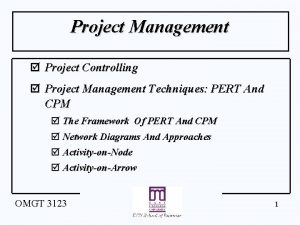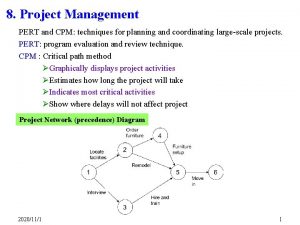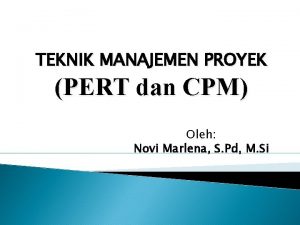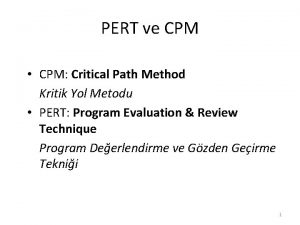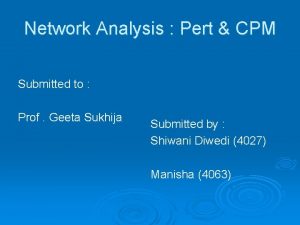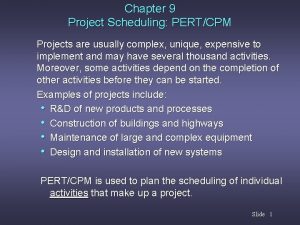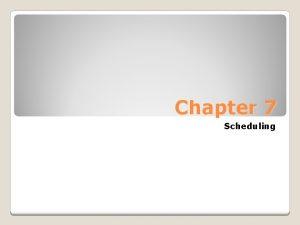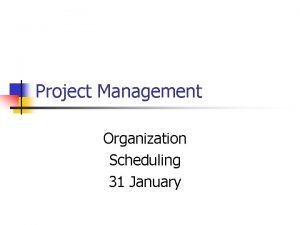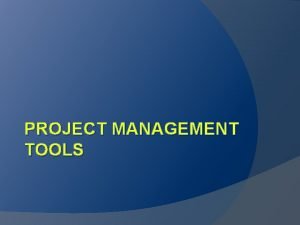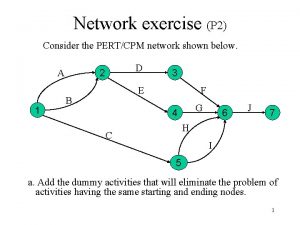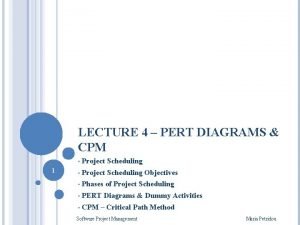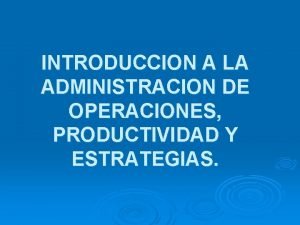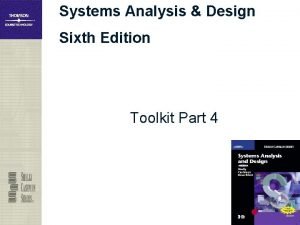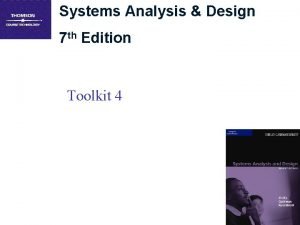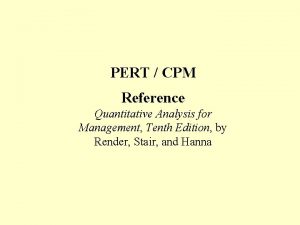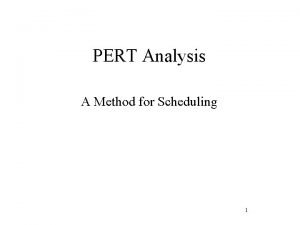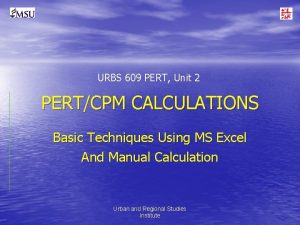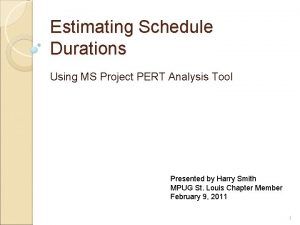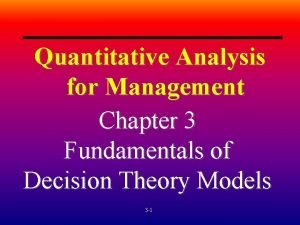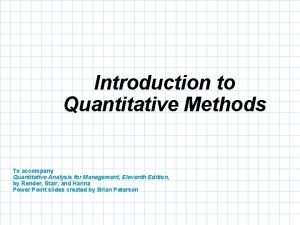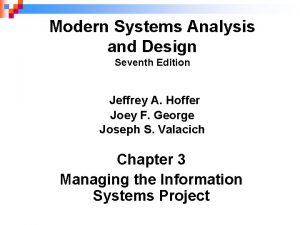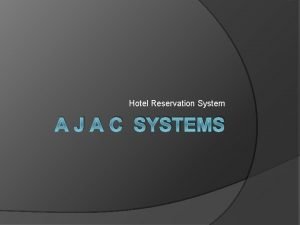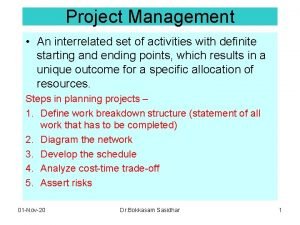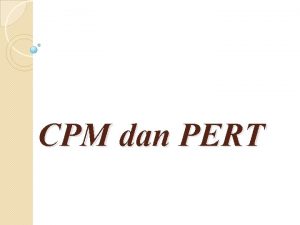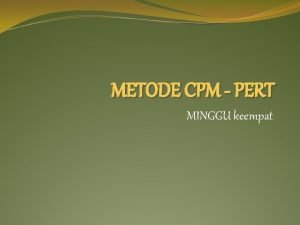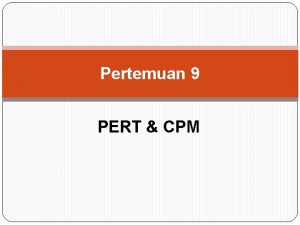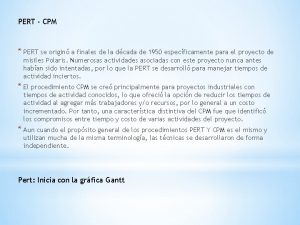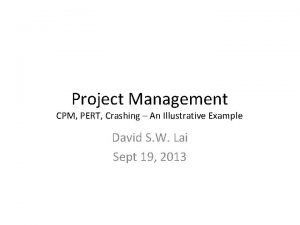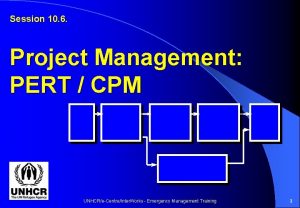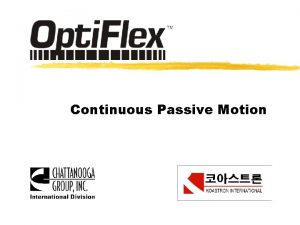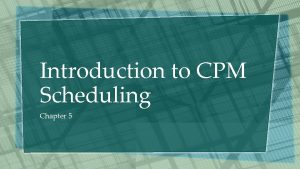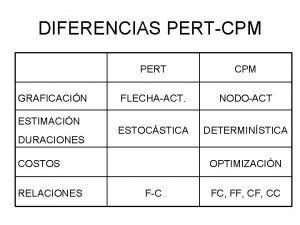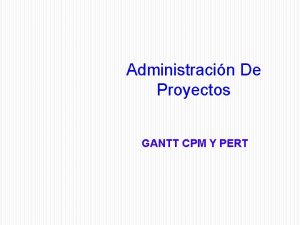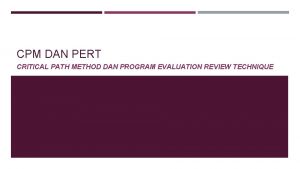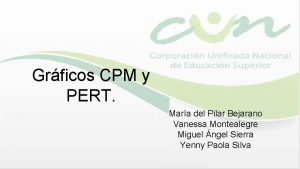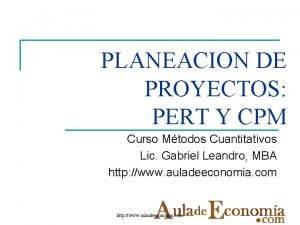PERT CPM Reference Quantitative Analysis for Management Tenth



































- Slides: 35

PERT / CPM Reference Quantitative Analysis for Management, Tenth Edition, by Render, Stair, and Hanna

Introduction • Most realistic projects are large and complex • Tens of thousands of steps and millions of dollars may be involved • Managing large-scale, complicated projects effectively is a difficult problem and the stakes are high • The first step in planning and scheduling a project is to develop the work breakdown structure • Time, cost, resource requirements, predecessors, and people required are identified for each activity • Then a schedule for the project can be developed 2

Introduction • The Program Evaluation And Review Technique (PERT) PERT and the Critical Path Method (CPM) CPM are two popular quantitative analysis techniques to help plan, schedule, monitor, and control projects • Differed in how they estimated activity times • PERT used three time estimates to develop a probabilistic estimate of completion time • CPM was a more deterministic technique • They have become so similar they are commonly considered one technique, PERT/CPM 3

Six Steps of PERT/CPM 1. Define the project and all of its significant activities or tasks 2. Develop the relationships among the activities and decide which activities must precede others 3. Draw the network connecting all of the activities 4. Assign time and/or cost estimates to each activity 5. Compute the longest time path through the network; this is called the CRITICAL PATH 6. Use the network to help plan, schedule, monitor, and control the project 4

PERT/CPM Given the large number of tasks in a project, what you would want to know: 1. When will the entire project be completed? 2. What are the critical activities or tasks in the project, that is, the ones that will delay the entire project if they are late? 3. Which are the non-critical activities, that is, the ones that can run late without delaying the entire project’s completion? 4. If there are three time estimates, what is the probability that the project will be completed by a specific date? 5

PERT/CPM 5. At any particular date, is the project on schedule, behind schedule, or ahead of schedule? 6. On any given date, is the money spent equal to, less than, or greater than the budgeted amount? 7. Are there enough resources available to finish the project on time? 6

General Foundry Example of PERT/CPM • General Foundry, Inc. has long been trying to avoid the expense of installing air pollution control equipment • The local environmental protection group has recently given the foundry 16 weeks to install a complex air filter system on its main smokestack • General Foundry was warned that it will be forced to close unless the device is installed in the allotted period • They want to make sure that installation of the filtering system progresses smoothly and on time 7

General Foundry Example of PERT/CPM • Activities and immediate predecessors for General Foundry ACTIVITY DESCRIPTION IMMEDIATE PREDECESSORS A Build internal components — B Modify roof and floor — C Construct collection stack A D Pour concrete and install frame B E Build high-temperature burner C F Install control system C G Install air pollution device D, E H Inspect and test F, G 8

Drawing the PERT/CPM Network Two approaches: • Activity-on-node (AON) AON where the nodes represent activities • Activity-on-arc (AOA) AOA where the arcs are used to represent the activities • The AON approach is easier and more commonly found in software packages • One node represents the start of the project, one node for the end of the project, and nodes for each of the activities • The arcs are used to show the predecessors for each activity 9

General Foundry Example of PERT/CPM A C F Build Internal Components Construct Collection Stack Install Control System Start E H Build Burner Inspect and Test B D G Modify Roof and Floor Pour Concrete and Install Frame Install Pollution Device Finish 10

Activity Times Activity times known with certainty • CPM assigns just one time estimate to each activity and this is used to find the critical path Uncertainty about activity times • PERT employs a probability distribution based on three time estimates for each activity A weighted average of these estimates is used for the time estimate and this is used to determine the critical path 11

Activity Times Optimistic time (a) = time an activity will take if everything goes as well as possible. There should be only a small probability (say, 1/100) of this occurring. Pessimistic time (b) = time an activity would take assuming very unfavorable conditions. There should also be only a small probability that the activity will really take this long. Most likely time (m) = most realistic time estimate to complete the activity 12

Activity Times PERT assumes time estimates follow a beta probability distribution Probability of 1 in 100 of (a) Occurring Probability of 1 in 100 of (b) Occurring Most Optimistic Time (a) Most Likely Time (m) Activity Time Most Pessimistic Time (b) 13

Activity Times Expected activity time (t) Variance of activity completion time 14

Activity Times Time estimates (weeks) for General Foundry EXPECTED ACTIVITY OPTIMISTIC a MOST PROBABLE m A 1 2 3 2 4/36 B 2 3 4/36 C 1 2 3 2 4/36 D 2 4 6 4 16/36 E 1 4 7 4 36/36 F 1 2 9 3 64/36 G 3 4 11 5 64/36 H 1 2 3 2 4/36 TIME, PESSIMISTIC b t = [(a + 4 m + b)/6] VARIANCE [(b – a)/6]2 25 15

How to Find the Critical Path • Use the expected completion time for each task as the actual time • The total of 25 weeks does not take into account for tasks taking place at the same time • How long the project will take? Critical Path analysis for the network to identify the longest path through the network 16

How to Find the Critical Path A 2 C 2 F E 3 4 H Start 2 Finish B 3 D 4 G 5 17

How to Find the Critical Path Compute for each activity: 1. Earliest start time (ES): ES the earliest time an activity can begin without violation of immediate predecessor requirements 2. Earliest finish time (EF): EF the earliest time at which an activity can end 3. Latest start time (LS): LS the latest time an activity can begin without delaying the entire project 4. Latest finish time (LF): LF the latest time an activity can end without delaying the entire project 18

How to Find the Critical Path • For each activity time, early and late start and finish times are represented in the following manner ACTIVITY ES LS t EF LF Earliest finish time = Earliest start time + Expected activity time EF = ES + t Earliest start =Largest of the earliest finish times of immediate predecessors ES = Largest EF of immediate predecessors 19

How to Find the Critical Path • At the start of the project we set the time to zero • Thus ES = 0 for both A and B A ES = 0 t=2 EF = 0 + 2 = 2 B ES = 0 t=3 EF = 0 + 3 = 3 Start 20

How to Find the Critical Path A 0 2 2 C 2 2 4 F 4 E 4 Start B 0 3 3 D 3 4 7 3 7 4 8 H 13 G 8 2 15 Finish 5 13 21

How to Find the Critical Path Latest start time = Latest finish time – Expected activity time LS = LF – t Latest finish time = Smallest of latest start times for following activities LF = Smallest LS of following activities LS = LF – t = 15 – 2 = 13 weeks 22

How to Find the Critical Path A 0 0 2 2 2 C 2 2 2 4 4 F 4 10 E 4 4 Start B 0 1 3 3 4 D 3 4 4 7 8 3 7 13 4 8 8 H 13 13 G 8 8 2 15 15 Finish 5 13 13 23

How to Find the Critical Path • Once ES, LS, EF, and LF have been determined, it is a simple matter to find the amount of slack time that each activity has Slack = LS – ES, or Slack = LF – EF • Activities A, C, E, G, and H have no slack time • These are called critical activities and they are said to be on the critical path • The total project completion time is 15 weeks • Industrial managers call this a boundary timetable 24

How to Find the Critical Path • General Foundry’s schedule and slack times ACTIVITY EARLIEST START, ES EARLIEST FINISH, EF LATEST START, LS LATEST FINISH, LF SLACK, LS – ES ON CRITICAL PATH? A 0 2 0 Yes B 0 3 1 4 1 No C 2 4 0 Yes D 3 7 4 8 1 No E 4 8 0 Yes F 4 7 10 13 6 No G 8 13 0 Yes H 13 15 0 Yes 25

How to Find the Critical Path A 0 0 2 2 2 C 2 2 2 4 4 F 4 10 E 4 4 Start B 0 1 3 3 4 D 3 4 4 7 8 3 7 13 4 8 8 H 13 13 G 8 8 2 15 15 Finish 5 13 13 26

Probability of Project Completion • The critical path analysis gives the expected project completion time of 15 weeks • But variation in activities on the critical path can affect overall project completion, and this is a major concern • If the project is not complete in 16 weeks, the foundry will have to close • PERT uses the variance of critical path activities to help determine the variance of the overall project Project variance = ∑ variances of activities on the critical path 27

Probability of Project Completion ACTIVITY VARIANCE A 4/36 B 4/36 C 4/36 D 16/36 E 36/36 F 64/36 G 64/36 H 4/36 Project variance = 4/36 + 36/36 + 64/36 + 4/36 = 112/36 = 3. 111 28

Probability of Project Completion Assume activity times are independent and total project completion time is normally distributed 29

Probability of Project Completion Standard Deviation = 1. 76 Weeks 15 Weeks (Expected Completion Time) 30

Probability of Project Completion Standard Normal equation • Using a Standard Normal table, the probability of 0. 71566 associated with this Z value • That means there is a 71. 6% probability this project can be completed in 16 weeks or less 31

Probability of Project Completion Probability of meeting the 16 -week deadline Expected Time is 15 Weeks 0. 57 Standard Deviations Probability (T ≤ 16 Weeks) is 71. 6% 15 Weeks 16 Weeks Time 32

What PERT Was Able to Provide • The project’s expected completion date is 15 weeks • There is a 71. 6% chance that the equipment will be in place within the 16 -week deadline • Five activities (A, C, E, G, H) are on the critical path • Three activities (B, D, F) are not critical but have some slack time built in • A detailed schedule of activity starting and ending dates has been made available 33

Sensitivity Analysis and Project Management • The time required to complete an activity can vary from the projected or expected time • If the activity is on the critical path, the completion time of the project will change • This will impact ES, EF, LS, and LF times for other activities • The exact impact depends on the relationship between the various activities • A predecessor activity is one that must be accomplished before the given activity can be started • A successor activity is one that can be started only after the given activity is finished 34

Sensitivity Analysis and Project Management SUCCESSOR ACTIVITY TIME PARALLEL ACTIVITY PREDECESSOR ACTIVITY Earliest start Increase (decrease) No change Earliest finish Increase (decrease) No change Latest start Increase (decrease) No change Latest finish Increase (decrease) No change Slack No change Increase (decrease) No change Predecessor Activity Successor Parallel 35
 Project management pert
Project management pert Cpm in project management
Cpm in project management Simbol yang menyatakan sebuah dummy
Simbol yang menyatakan sebuah dummy Cpm analizi
Cpm analizi Independent float formula
Independent float formula Pert/cpm example problems with solutions doc
Pert/cpm example problems with solutions doc Dangling error in network
Dangling error in network Cpm/pert (dupont 1957)
Cpm/pert (dupont 1957) Cpm/pert (dupont 1957)
Cpm/pert (dupont 1957) Pert/cpm
Pert/cpm Pert/cpm example problems with solutions doc
Pert/cpm example problems with solutions doc Cpm investigacion de operaciones
Cpm investigacion de operaciones Pert and cpm
Pert and cpm Pert/cpm
Pert/cpm Cpm
Cpm Pert
Pert Cpm in quantitative techniques
Cpm in quantitative techniques Introduction to genetic analysis tenth edition
Introduction to genetic analysis tenth edition Pert analysis
Pert analysis Pert calculations
Pert calculations Ms project pert
Ms project pert Quantitative analysis for management chapter 3 answers
Quantitative analysis for management chapter 3 answers Define quantitative analysis
Define quantitative analysis Pert project management example
Pert project management example Hotel reservation system documentation doc
Hotel reservation system documentation doc Concurrent activity in network diagram
Concurrent activity in network diagram Customer portfolio matrix
Customer portfolio matrix Reference node and non reference node
Reference node and non reference node Reference node and non reference node
Reference node and non reference node The tenth man graham greene summary
The tenth man graham greene summary Round the following numbers to the nearest hundreds 625
Round the following numbers to the nearest hundreds 625 Campbell biology tenth edition
Campbell biology tenth edition Campbell biology tenth edition
Campbell biology tenth edition Campbell biology tenth edition
Campbell biology tenth edition Round of 75
Round of 75 Round off 37
Round off 37
